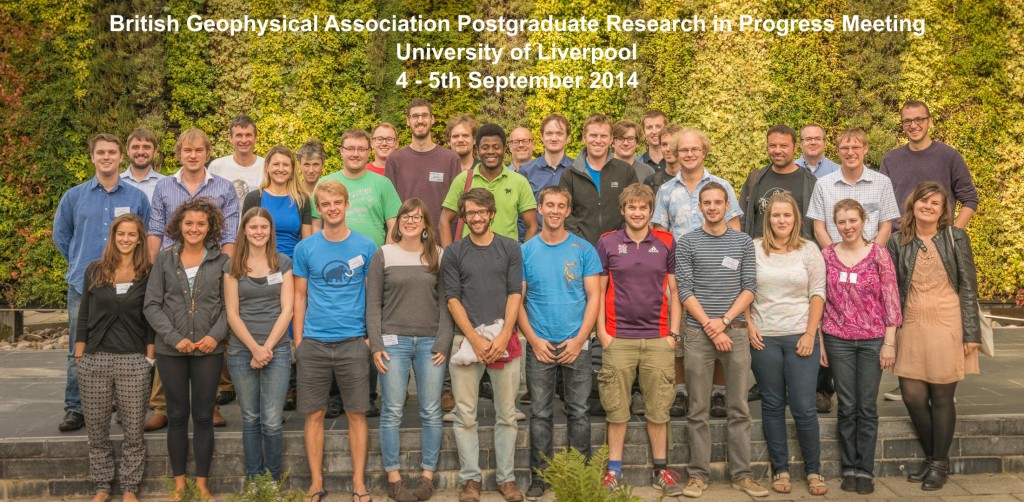Six PhD students from the Geology and Geophysics research group presented their work at the annual British Geophysical Association Postgraduate Research in Progress Meeting, hosted by the University of Liverpool. Seismologists Ryan Gallacher, Jenny Neale and Thomas Hall, and Marine Geophysicists Richard Davy, Tim Hughes and John Emeana presented a broad range of work including imaging mantle structure using earthquake seismic data, imaging passive rift margins with seismic reflection data, laboratory and computational experiments studying undersea high voltage cables and studying deep-water infragravity waves using differential pressure gauges. Ryan presented his research imaging the mantle structure beneath the Afar triple junction and the Main Ethiopian rift. Surface wave tomography was used to produce a 3D shear velocity model for the region, which showed pronounced low velocity anomalies segmented along the Main Ethiopian rift and into Afar from 40-150 km depth. These are interpreted as resulting from significant amounts of partial melt (<1%). The segmented zones of melting indicate that buoyancy driven active upwelling of the mantle initiates early during continental rifting and controls melt volumes throughout breakup. Additionally, enhanced melting at the Central Main Ethiopian Rift may result from 3-D melt focusing along lithospheric topography. Richard is looking to refine the kinematics and structure of continental hyper-extension, as well as to delimit the seaward extent of the ocean-continent transition at the Galicia Bank rift margin in the northeast Atlantic Ocean. The Iberian rift margin, which includes the Galicia Bank, is a type example of ultra-slow magma-poor rift margin and has been the subject of numerous geophysical studies which look to resolve the processes which occur in the very late stages of continental breakup. These studies have revealed the presence of large rotated continental fault blocks that are situated above a large detachment fault, known as the S-reflector, which has exhumed serpentinised mantle peridotite to the sea-floor, and the enigmatic Peridotite Ridge (PR) to the west of these features. Using 2D wide angle data from the Galicia-3D seismic experiment, Richard has produced First Arrival Seismic Tomography (FAST) models and basic gravity models of this margin, which reveal the P-wave velocity structure of these structures and the unidentified basement west of the PR. These initial results show little evidence of oceanic crust directly west of the PR, and tend to indicate the continued presence of exhumed and serpentinised mantle, analogous to areas of the Southwest Indian ridge, a similar ultra-slow spreading margin. Tim gave a talk introducing some of the work that he has been involved with in determining how certain environmental variables affect the thermal conditions experienced by submarine high voltage cables. 2D finite element method simulations were developed to examine how changing the sediment permeability and thermal conductivity, as well as the cable burial depth influenced the nature of the heat flow in and around the cable. The models suggest that the permeability is the most important parameter in characterising the heat flow, as it largely determines how much heat can be transferred from the cable by convective processes. John’s research is focused on understanding the spatial and temporal variability of pre/post-installation physical and thermal environment of buried subsea HV cables, using laboratory and field data (high resolution seismic, geotechnical and in-situ thermal measurements) acquired along HV cable routes across the UK shelf. This is due to significant growth in the use of sub-sea floor HV cables for offshore windfarms and the proposed Super Grid development. Also these cables with surface temperature of up to 90oC are usually buried 1-2m within local seabed sediments with little thought about the thermal regime they will either enter or generate. However, critical to their performance is the rate of heat transfer into the surrounding sediment, as excessive temperature of the burial environment will have significant implications such as premature degradation of the cable insulation, ampacity and reliability; leading to early failure of such multi-million pounds cable links. Jenny presented some work on infragravity waves, responsible for the low frequency seismic noise known as earth’s “seismic hum”. The directional characteristics of deep-water infragravity waves in the northeast Pacific were studied using an array of differential pressure gauges deployed as part of the Cascadia Initiative OBS array. Asymmetry of cross correlation functions between each station pair showed that offshore propagation dominated most days between September 2012-May 2013. On certain days (January 17-18th 2013, April 4th 2013, and October 6th 2012) when local swell energy was low, infragravity waves from remote sources were observed to propagate towards the shore, and reflect strongly at the coastline. Tom presented his recent work on developing a method to use both local and teleseismic arrival times to jointly invert for velocity structure of the Sumatran subduction zone. The advantage of using a joint inversion is that it allows us to better resolve the sub-slab mantle compared to using either local or teleseismic methods separately. From preliminary results an interesting feature of the model is the presence of a low velocity structure beneath the subducting Sumatran plate which generated much debate amongst colleagues at the BGA. At the close of the meeting a panel of learned judges decided on the best presentation and poster from throughout the proceedings. The judges commented on the high quality of science and impressive standard of presentations at the conference, which made the awarding of best presentation to Southampton’s Tim Hughes all the more notable. Southampton’s students addressed the conference at its conclusion to thank Liverpool for hosting an excellent conference and to invite all attendees to the 2015 British Geophysical Association Postgraduate Research in Progress Meeting which the University of Southampton is hosting.
